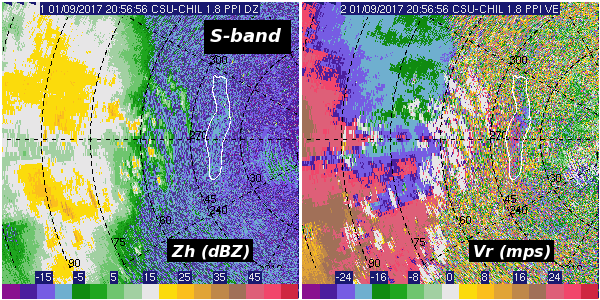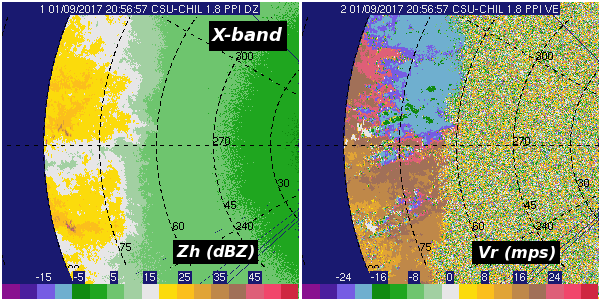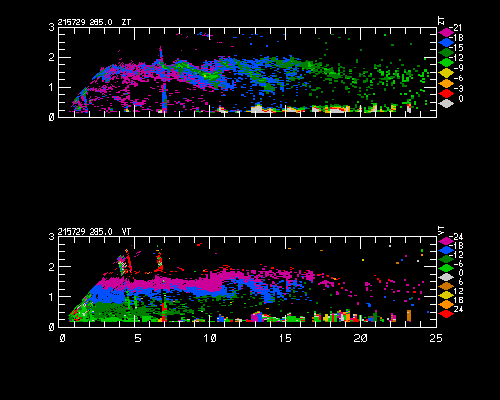DPWX/Breaking lee waves: 9 January 2017: Difference between revisions
Pat kennedy (talk | contribs) No edit summary |
Pat kennedy (talk | contribs) (Starting text development.) |
||
| Line 1: | Line 1: | ||
==Overview== | |||
Strong westerly synoptic-scale winds flowed over the Rocky Mountains in Colorado on 9 January 2017. The NWS Denver / Boulder forecast office issued a high wind warning that generally covered the western half of the CSU-CHILL radar's coverage area. The radar scanning procedures included a period of continuous RHI scans that swept the 285 deg azimuth at ~2 minute time intervals. This RHI direction sampled an area in the immediately downstream of the mountain barrier with respect to the strong westerly wind field. Bragg scattering echo patterns observed in the S-band reflectivity data showed evidence of wave motions in lowest few km of the atmosphere in the lee of the mountains. | |||
==PPI scan data at 2058 UTC== | |||
A short period of 360 degree surveillence scans were done when the radar operations were started. The following plot shows the S-band reflectivity and radial velocity data at an elevation angle of 1.8 deg. The irregular boundary encloses the weak Bragg scattering associated with localized turbulence in the lee wave flow. (To retain this weak (~ -10 to -12 dBZ) echo, no thresholding was applied to the data). In the reflectivity data (left panel), conventional meteorological echo was received from the snow that developed as the moisture-laden pacific airmass was lifted over the mountains (i.e., beyond ~60 km range to the west of the radar). The radial velocity pattern in the right panel shows that the inbound radial velocities exceeded the Nyquist velocity (27 mps) in various areas of both the Bragg and snow echoes. The 1 deg width of the S-band beam pattern also caused ground clutter to appear in some of the higher terrain areas. | |||
[[Image:9jan2017 2058 SB solo anot.png|center]] | [[Image:9jan2017 2058 SB solo anot.png|center]] | ||
The next plot shows a similar presentation of the X-band data from the same PPI sweep; once again, no thresholding was applied. No evidence of the lee wave echo is seen, instead only noise indications are seen in the area to the area downstream of the mountains. Bragg scattering echoes at X-band are typically ~ 19 dB weaker than the returns received at S-band (Knight and Miller, BAMS 1993, p.179 - 188). Thus, lee wave echo was well below the X-band system's noise level. Within the precipitation echo over the mountains, the reflectivity levels observed at X and S-bands were quite similar. The narrower (0.3 deg), lower sidelobe X-band antenna pattern greatly reduced the amount of ground return in the X-band data vs. that seen in the S-band data. | |||
[[Image:9jan2017 2058 XB solo anot.png|center]] | [[Image:9jan2017 2058 XB solo anot.png|center]] | ||
==S-band RHI scan at 2110 UTC== | |||
[[Image:9jan2017 2110 0 50km SB RHI v anot.png|center]] | [[Image:9jan2017 2110 0 50km SB RHI v anot.png|center]] | ||
Revision as of 13:03, 26 January 2017
Overview
Strong westerly synoptic-scale winds flowed over the Rocky Mountains in Colorado on 9 January 2017. The NWS Denver / Boulder forecast office issued a high wind warning that generally covered the western half of the CSU-CHILL radar's coverage area. The radar scanning procedures included a period of continuous RHI scans that swept the 285 deg azimuth at ~2 minute time intervals. This RHI direction sampled an area in the immediately downstream of the mountain barrier with respect to the strong westerly wind field. Bragg scattering echo patterns observed in the S-band reflectivity data showed evidence of wave motions in lowest few km of the atmosphere in the lee of the mountains.
PPI scan data at 2058 UTC
A short period of 360 degree surveillence scans were done when the radar operations were started. The following plot shows the S-band reflectivity and radial velocity data at an elevation angle of 1.8 deg. The irregular boundary encloses the weak Bragg scattering associated with localized turbulence in the lee wave flow. (To retain this weak (~ -10 to -12 dBZ) echo, no thresholding was applied to the data). In the reflectivity data (left panel), conventional meteorological echo was received from the snow that developed as the moisture-laden pacific airmass was lifted over the mountains (i.e., beyond ~60 km range to the west of the radar). The radial velocity pattern in the right panel shows that the inbound radial velocities exceeded the Nyquist velocity (27 mps) in various areas of both the Bragg and snow echoes. The 1 deg width of the S-band beam pattern also caused ground clutter to appear in some of the higher terrain areas.

The next plot shows a similar presentation of the X-band data from the same PPI sweep; once again, no thresholding was applied. No evidence of the lee wave echo is seen, instead only noise indications are seen in the area to the area downstream of the mountains. Bragg scattering echoes at X-band are typically ~ 19 dB weaker than the returns received at S-band (Knight and Miller, BAMS 1993, p.179 - 188). Thus, lee wave echo was well below the X-band system's noise level. Within the precipitation echo over the mountains, the reflectivity levels observed at X and S-bands were quite similar. The narrower (0.3 deg), lower sidelobe X-band antenna pattern greatly reduced the amount of ground return in the X-band data vs. that seen in the S-band data.

S-band RHI scan at 2110 UTC

9 Jan 2017 S-band 285 deg RHI data: 2 minute time intervals 2157:59 - 2229:30 UTC
|
|
||
|
